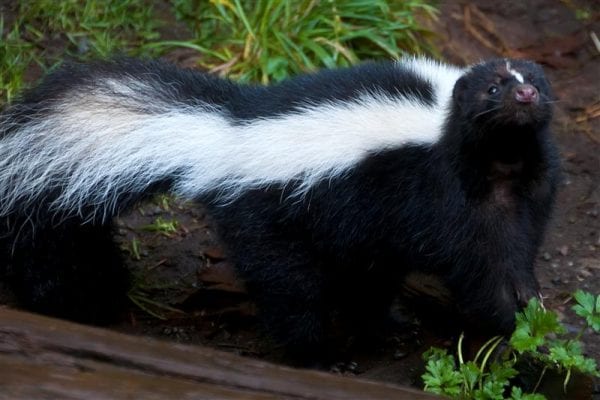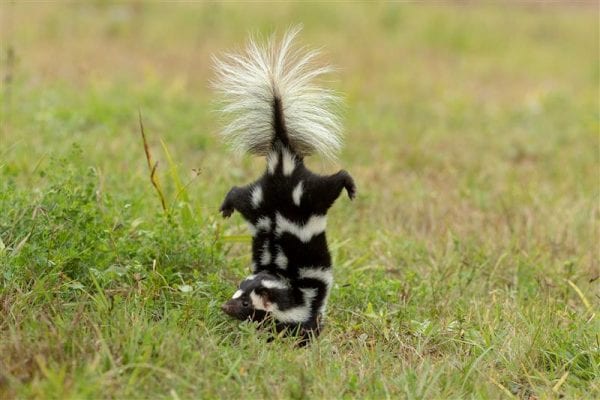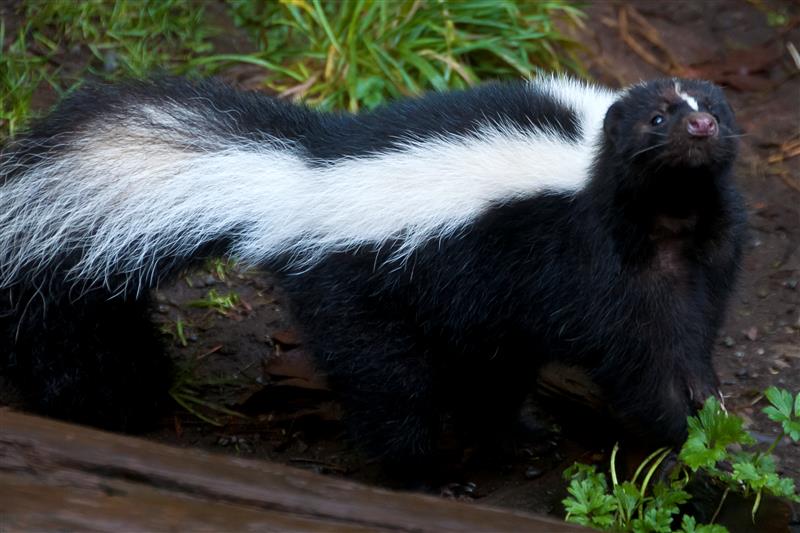Forestry & Wildlife

Even if an individual has never seen a skunk, they almost certainly have smelled one. Formerly classified as part of the weasel family, skunks are now recognized as belonging to their own distinct family. Skunks are most well known for, and often avoided because of, their well-developed anal glands that produce musk with an offensive sulfurous odor. While skunks can only accurately spray around 10 feet, the scent itself can often be smelled from over a half-mile away.
Skunks in Alabama

Striped skunks are the larger and more common of the two native skunk species.
Alabama is home to two species of skunk – the striped skunk and the eastern spotted skunk. Most Alabamians are familiar with the former. Both species have white and black aposematic (don’t eat me or you’ll regret it) coloration, but there are some noticeable differences. Striped skunks are the larger of the two with adults being about the size of a full-grown house cat. As their name properly implies, this species is striped. If drivers see a dead skunk in the middle of the road, it’s likely the striped skunk. They’re by far the more abundant and easily observed of Alabama’s two species. Unsurprisingly, the eastern spotted skunk often has a spotted appearance. An arguably bigger difference between the two skunk species, however, is size. Spotted skunks are significantly smaller than their striped relatives. An adult spotted skunk is only about the size of a squirrel.
Spotted skunks are uncommon, too, and researchers do not know a lot about their biology. Although they likely occur across the entire state, they’re rarely seen. Because their current status isn’t well known, state biologists encourage any Alabamians that may encounter them to submit their observations to assist with their research. Any photo is a good one – whether it be an incidental encounter, as roadkill, from game cameras, or inadvertent catch from fur trapping (more of that below).
If you have any photographs of spotted skunks in Alabama, please consider submitting them one of two ways:
- Upload your observation to the Eastern Spotted Skunk project on iNaturalist either through a browser or with the app on your mobile device.
- Send an email with the photograph to Nick Sharp. Don’t forget to include GPS coordinates.
Skunk-Human Interactions

Eastern spotted skunks are only about the size of a squirrel. This species will do a handstand prior to spraying.
Although most people think of skunk-human interactions solely in negative terms, the striped skunk is classified as a furbearer in the state. The only legal method of harvest is trapping with the season generally running from November through February. Spotted skunks, however, cannot be legally harvested. Efforts should be made to release an inadvertently trapped spotted skunks unharmed. If a spotted skunk is trapped, consider taking a picture and submitting it.
Skunks can cause problems for people in several ways aside from the infamous stink. They can cause damage to lawns, golf courses, and gardens while foraging for food. They may also occasionally raid chicken coops, but are not as proficient at this as other predators. As per state regulations, it is legal for landowners or tenants to remove one striped skunk per damage incident without a permit. Because spotted skunks are protected, they should not be harmed. Both species are also susceptible to rabies so avoid direct contact whenever possible.
What to Do if You or Your Pet Has Been Sprayed
The biggest worry for most people when it comes to skunks is the possibility of getting sprayed. If you or your pet get sprayed, there are commercially available products on the market to deal with skunk musk. If you’re more of a DIY person, there’s an at-home recipe that effectively neutralizes skunk odor. You’ll need the following:
- 1 quart 3 percent hydrogen peroxide
- ¼ cup baking soda
- 1 teaspoon of dish soap
Mix together and apply immediately. It can be used on both pets and people, but be sure to avoid the eyes and mouth. The mixture should be allowed to set for five minutes before rinsing with water. If an inanimate object has been sprayed, 1 cup of bleach mixed with a gallon of water will help eliminate the smell, but be careful about bleach stains. Contrary to popular belief, tomato juice doesn’t eliminate skunk odor. It simply masks it instead of neutralizing it.

